Abstract
Anthropogenic noise is a growing threat to marine life due to the incrementation of human activity in the marine environment. In Europe, the Directive 2008/56/EC of the European Parliament and of the Council was published with the aim of establishing a framework for community action in the field of marine environmental policy. The directive introduces underwater acoustic energy, as detailed in Descriptor 11, and stipulates that the member states should set the threshold levels at which a good environmental status can be achieved by means of long-term monitoring campaigns. This research presents the results of a long-term underwater noise monitoring campaign with a duration of three years in the port of Cartagena located on the south-eastern coast of Spain, focusing on the monthly and annual variation patterns of low-frequency continuous noise. The acquired data are classified according to the source of the acoustic noise into shipping, other anthropogenic, and natural noise measurements. These three groups of measurements are processed in order to obtain one-third octave band levels centered at 63 and 125 Hz, as well as the overall bandwidth of unweighted Sound Pressure Level (SPL). The analysis of the measurements shows an increase in the annual average overall band of 4 and 3 dB of the natural and shipping noise, respectively, from 2013 to 2015. This monitoring campaign provides accurate acoustic values to establish threshold levels to achieve good environmental status and recommendations to conduct monitoring programs and regulations to control underwater noise pollution.
1. Introduction
Human activity in the maritime environment is increasing the level of underwater ambient noise. Wenz [1] established the first recognised ambient noise level reference that included different weather conditions and shipping traffic densities. The underwater acoustic community has widely adopted these ambient noise levels; even nowadays, these levels are used to specify the requirements of underwater equipment such as sonar, sonobuoy processing, and acoustic measurement systems. The ambient noise spectrum was converted into modern units by Richardson [2] and redrawn by Robinson [3]. Hildebrand [4] updated the ambient noise spectrum, including the higher levels of low-frequency noised caused by increased anthropogenic activity. The most relevant differences appear in the low-frequency band, where shipping noise exceeds natural noise, which was previously the predominant noise in this band.
The definition of ambient noise has evolved over the years, mainly due to the development of new applications and underwater acoustic systems and the emergence of new sources of man-made noise. Initially, the definition of ambient noise focused on the analysis of the detection capability of sonar systems. Urick [5] defined ambient noise as that part of the total noise background that can observed using a non-directional hydrophone, but which is not due to the hydrophone and its manner of mounting (self-noise), or to some identifiable localized source of noise. With the increase in the number of sources of man-made underwater noise, new definitions of ambient noise have appeared. Anthropogenic sounds, called anthrophonies, include any sound that originates from human activity [6]. Ambient noise is defined as all sound except for that resulting from the deployment, operation or recovery of the recording equipment and its associated platform, where all sound includes both natural and anthropogenic sounds [7].
Sources of ambient noise have, in the past, been classified as physical, biological and man-made sources [8]. Nowadays, the sources of noise can be classified as either natural and man-made noise for the purposes of the development of studies on the evolution and impact of acoustic pollution in the maritime medium. Natural noise sources include sounds of physical and biological origin. and can be referred to as either geophonies or biophonies [6].
Upon analysing the long-term trends of ambient noise in the low-frequency bandwidth between 10 Hz and 220 Hz, the sound levels were found to have increased by 10 dB per decade or more between 1950 and 1975 [9,10], suggesting that low-frequency ambient noise increased at an average rate of about 0.5 dB per year [11]. Bjorno [12] indicated that, since World War II, the average level of the ambient noise has increased by 12–15 dB. Andrew [13] determined that the ambient noise over a 33-year period increased by approximately 10 dB on the basis of observations made at a site off the central coast of California. Mazzuca [14] concluded that the overall increase in low-frequency noise from 1950 to 2000 was 16 dB. McDonald [15] and Chapman [16] confirmed the increase in these sound levels.
The main source of underwater acoustic pollution is shipping traffic [10,11,17,18,19]. Shipping noise is a combination of tonal sounds and broadband noise spread over the frequency range between 2 Hz and 100 kHz, and is generated mainly by propeller cavitation, onboard machinery, and turbulence around the hull [17,20].
The rise in underwater noise levels caused by increasing shipping traffic, in terms of both number of ships and gross tonnage [21], may have negative effects—both physical and behavioural—on marine organisms. Potential effects include acoustic masking [22,23,24,25,26,27,28], increased stress and risk of mortality [29,30,31,32,33], and changes in behavioural responses [30,34,35,36,37,38,39,40]. Changes in behavioural responses could have possible consequences with respect to breeding success [41,42,43]. Another consequence of the changes in behavioural response is predator and habitat avoidance [44,45,46,47,48].
The International Maritime Organization (IMO) has recognised the negative impact of excessive underwater noise levels [49], introducing voluntary guidelines aimed at ship designers, shipyards, and operators, with the aim of reducing the contribution of commercial shipping to underwater acoustic pollution.
In Europe, the Directive 2008/56/EC of the European Parliament and of the Council of 17th June 2008 [50] was published with the aim of establishing a framework for community action in the field of marine environmental policy, the Marine Strategy Framework Directive (MSFD). This directive introduced underwater acoustic pollution, as detailed in Descriptor 11. The Commission Decision 2010/477/EU [51] on the criteria and methodological standards for Good Ambient Status (GES) of marine waters put forward two attributes: loud, low- and mid-frequency impulsive sounds (11.1.1), and continuous low-frequency sounds (11.2.1). The implementation of MSFD Descriptor 11 was followed and supported by the MSFD Technical Subgroup on Underwater Noise (TSG Noise), who provided detailed definitions and recommendations for monitoring and measuring its evolution [52].
The threshold values for achieving good environmental status must be set on the basis of long-term monitoring campaigns using hydrophones. There are two main types of deployment of hydrophones for underwater sound monitoring, although a new method based on the use of hydrophones integrated in underwater vehicles is emerging [53]. This method has the great advantage of the hydrophones being integrated into a mobile platform, and therefore it is possible to cover large areas for acoustic monitoring. The problem with this method is the additional noise resulting from the presence of the self-noise and flow noise of the platform. Additionally, the cost of this system is more expensive than others, so at present it has not yet been widely used.
With respect to typical extended methods, the first uses a hydrophone or an array of them deployed from a surface buoy, and is called surface deployment; the second one uses a sensor or an array of them deployed at the sea bottom, and is called bottom-mounted deployment. ‘The bottom-mounted deployment is preferable to a surface deployment to minimise parasitic signals (for example from the influence of surface wave action), to keep the hydrophone away from the pressure release water-air surface and minimise disturbance by surface vessels’ [52]. Bottom-mounted deployment is the most silent type of deployment, minimizing the platform self-noise of the hydrophone, and avoiding moorings and hydrostatic pressure fluctuations of turbulence due to the interaction of the water flow with the acoustic sensor. The flow noise, mechanical noise, cable strum and wave action are parasitic signals that are not present in the measurements.
This paper presents the results of the acoustic analysis following a long-term monitoring campaign of acoustic surveillance using a bottom-mounted hydrophone deployment in shallow waters in the Mediterranean Sea on the south-eastern coast of Spain, in line with the definitions and recommendations of the TSG Noise [52]. The relevance of this research is the assessment of the monthly and annual trends of continuous acoustic noise using a great number of measurements, providing acoustic values that are useful for setting threshold levels in order to achieve good environmental status.
2. Materials and Methods
2.1. Study Area
The study area was the port of Cartagena (Figure 1), located on the south-eastern coast of Spain. The geographical location is longitude 0°59′ West and latitude 37°35′ North. The prevailing wind regime in the area is South South-West and South South-East, and its maximum tide is around 0.65 m. This area has an intense anthropogenic activity, with relevant merchant, passenger, fishing and recreative maritime traffic. Additionally, one of the most prominent naval bases of the Spanish Navy is located in Cartagena. However, measurements of navy ships were not performed, and therefore are not included in this research.
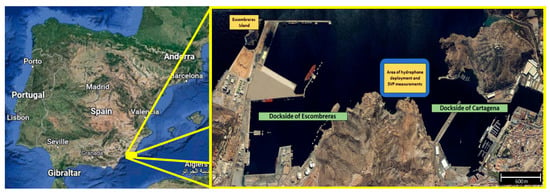
Figure 1.
Study area: Cartagena Port (Mediterranean Sea). Dockside of Cartagena and Escombreras.
The port of Cartagena is composed of two main docksides separated from each other and connected by road: one in Cartagena and the other in Escombreras. Located on the dockside of Cartagena is the terminal for cruiser, fishing, recreative, container and general merchant ships. Located on the dockside of Escombreras are the terminals for oil tankers, gas–oil, and other general merchant ships. The total numbers of large ships in the port during the years 2013, 2014 and 2015 were 1832, 1858 and 1957, respectively, and the total number of megatons of merchandise traffic were 29,511, 32,522 and 32,670, respectively [54,55,56].
To choose the proper location and depth for the sensor, it is necessary to conduct an acoustic survey in the study area before starting the monitoring campaign. The aim of acoustic surveying is to ensure that the acoustic energy radiated by the surface vessels reaches the sensor throughout the entire day; therefore, it involves the study of the scattering of sound energy and includes the calculation of the Sound Velocity Profile (SVP) and the distribution of the energy by means of acoustic propagation modeling.
The sound scattering in shallow water is conditioned by the speed of sound, which depends on temperature, salinity and depth, according to the equation developed by Mackenzie [57], as follows:
where is the temperature (°C), the salinity (psu), the depth (m), and is the speed of sound (m/s). The speed of sound increases when any of the three parameters increase, with the temperature being the most relevant factor. The speed of sound depends mainly on the temperature profile, because the variations in depth and salinity in shallow waters are small.
Sound scattering through the marine environment is conditioned by the seawater properties, source frequency, and source depth [5,58,59,60], and can be described mathematically by solving the wave equation using the appropriate boundary and medium conditions for a particular problem. The two main theoretical approaches to solving the wave equation in underwater acoustics are the so-called normal-mode theory, in which the propagation is described in terms of characteristic functions called normal modes, each of which is a solution of the equation, and the so-called ray theory, where the body of results and the conclusions drawn from them are referred to as acoustic rays [5].
As part of this research, an acoustic survey in the study area was performed to select the best location for the sensor and to verify that the bottom-mounted deployment was applicable. The SVP was obtained mathematically using Equation (1), and measurements of the temperature, salinity and depth were performed with an oceanography instrument known as a Conductivity–Temperature–Depth (CTD) Sea-Bird SBE-19 probe. The calculated SVP values were used as input to model the sound scattering based on the ray theory for the analyzed frequencies and all directions by means of the SEAPROF software toolbox developed by SAES for acoustic performance predictions.
2.2. Marine Traffic Monitoring
The Automatic Identification System (AIS) is a vessel-tracking system that operates on Very High Frequency (VHF) radio frequency bands. The AIS system is mandatory for ships with a gross tonnage of 300 gross and upwards, unless stated otherwise [61]. The European Directive does not apply to (a) warships, naval auxiliaries and other ships owned or operated by a Member State and used for non-commercial public service; (b) fishing vessels, traditional ships and recreational craft with a length of less than 45 metres; (c) bunkers below 5000 tons, ships’ stores, and equipment for use on board ships.
The acquisition system integrates an AIS receptor, but not all ships that navigate around the study area use the AIS system, and therefore these vessels would not have been detected or recorded by the deployed system. This implies that the classification of all measurements was performed using the information of the recorded AIS data and listening to the acoustic signals to identify the noise generated by ships without AIS system and other sources of anthropogenic noise.
The information used for each passing ship was the Maritime Mobile Service Identity (MMSI) number, the type of vessel, the tracking of its positions and the heading and speed while the measurement was taken.
2.3. Data Measurement
The selection of the final location of the sensor was performed following two steps. Firstly, a preselection of positions was carried out based on the criteria of locating the sensor in the areas with the highest density of maritime traffic [7]. Secondly, the preselected locations were verified on the basis of the analysis of sound propagation performed in the acoustic survey, in order to ensure that the sensor at these locations received the acoustic energy. The standard procedure used to measure surface ships in shallow waters was the STANAG 1136 [62].
The measurements were collected using an underwater multi-influence sensor manufactured by the Sociedad Anónima de Electronica Submarina (SAES), deployed on the sea bottom at a depth of 15 m (Figure 2). This sensor has the capability of simultaneously measuring magnetic, electric, pressure, seismic and acoustic signals.
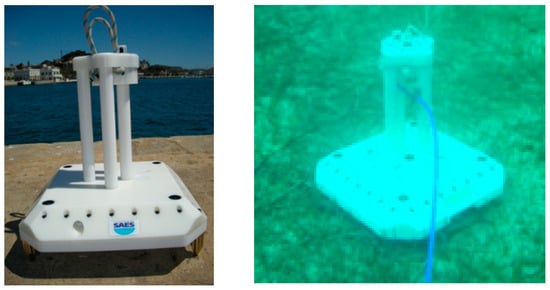
Figure 2.
Bottom-mounted underwater multi-Influence sensor before being deployed (left), and deployed at sea (right). The sensor unit integrates magnetic, electric, seismic, pressure and acoustic sensors. The hydrophone is mounted on the top of the unit, being at a distance from the sea bottom less than 1 m, in accordance with the standard STANAG 1136 [62].
The acoustic measurements were performed by means of an omnidirectional hydrophone calibrated according to the standard IEC 60565 [63] with a bandwidth of up to 8 kHz.
The acquisition process was controlled by means of an Automatic Identification System (AIS) [64]. A proprietary AIS system was integrated with the acquisition system to detect the presence of AIS-transmitting vessels close to the sensor, and subsequently commence taking measurements and recording their information. Furthermore, once a measurement of a ship was completed, a new automatic measurement was performed five minutes later, in order to evaluate the acoustic levels while the ship was passing over the sensor and when the ship was further away. The system recorded not only the information of the sensor, but also the information of the received AIS data of all ships close to the area. The integration of AIS to control the acquisition time provides great advantages in terms of the acquisition system working automatically without human intervention. However, the AIS data set transmitted from ships is not always complete, and sometimes lacks the name and type of the ship. For this reason, the recorded data from the AIS system must be post-processed and completed.
The acoustic measurements were performed from September 2013 to June 2015. During August and September, the system was stopped to perform maintenance tasks. Therefore, the sensor was working for a total duration of 20 months.
2.4. Classification of the Measurements
In this research, the complete set of measurements was classified into three types on the basis of an identification of the acoustic sources. The first group corresponds to measurements performed while a ship was passing over the sensor. These types of measurements are called shipping noise measurements. Figure 3 shows the time series of the amplitude, expressed in Pa, of two typical acoustic measurements of ships passing over the sensor.
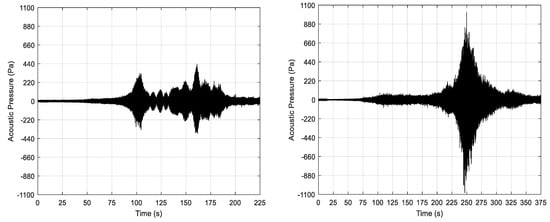
Figure 3.
Time series of the amplitude (in Pa) of acoustic measurements performed while a passenger ship was passing at a minimum distance of 11 m and speed of 6.5 knots (left) and while a merchant ship was passing at a minimum distance of 31 m and speed of 7.1 knots (right). These measurements are classified as Shipping Noise Measurements.
The second group corresponds to measurements of natural noise, characterized by a constant overall measurement of the acoustic envelope. Finally, the third group includes measurements containing anthropogenic sounds, such as the noise generated by the motors of small ships when they are starting and stopping continuously near the sensor, the noise generated by anchored ships, and the noise generated while the hull of the ships is cleaned at the dockside. These types of measurements are called other anthropogenic measurements. Figure 4 shows the time series of the amplitude expressed in Pa of two measurements classified as other anthropogenic measurements. The signal displayed on the left corresponds to the acoustic measurements obtained while cleaning the hull of a ship at dockside. This noise is composed of continuous and impulsive noise. The signal displayed on the right corresponds to an acoustic measurement performed while the motor of a small ship started and stopped several times near the sensor. For reference, Figure 4 shows in green colour the time series of the amplitude, expressed in Pa, of natural noise measurements.
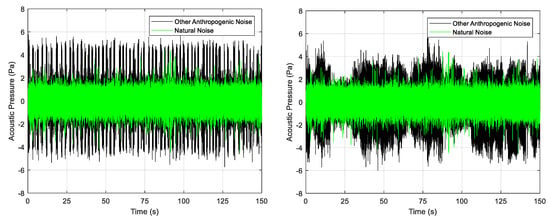
Figure 4.
Time series of the amplitude (in Pa) of Other Anthropogenic Noise (black) and Natural Noise (green) measurements. Acoustic measurements performed while cleaning the hull of an anchored ship (left). Acoustic measurements performed while the motor of a small ship started and stopped several times near the sensor (right).
The total number of measurements, including all three categories, was 11,494, corresponding to a total duration of 860.61 h.
2.5. Acoustic Data Analysis
The main sources of impulsive noise were identified as percussive pile driving for inshore and offshore construction, seismic surveys (using airguns) for inspecting subsea oil and gas deposits, explosions, and some sonar sources [7,65,66]. These impulsive sources are not localized to the study area; therefore, the analysis of the loud, low- and mid-frequency impulsive sounds with respect to the indicator 11.1.1 of the Descriptor D11 is not included in this study.
The acoustic data were sampled at 16,384 Hz and formatted at 32 bits. Signal processing was performed using a sample size of 32 bits for all acoustic parameters.
The acoustic parameters included were the unweighted Sound Pressure Level (SPL) and the mean square pressure in 1/3 octave bands. The acoustic quantities and units were defined in refs [67,68] in accordance with the standard ISO 18405 [69].
The unweighted Sound Pressure Level, expressed in dB with reference to 1 , is defined as follows:
where is the instantaneous sound pressure, is the reference sound pressure, and is the average time interval.
The 1/3 octave bands used for the analysis of the mean square pressure were those defined in the international standard IEC 61260 [70]. The center frequencies of the bands described by the European Commission [51], i.e., 63 and 125 Hz, are nominal. The signal analysis of the mean square pressure in the 1/3 octave bands used a Hanning window with an overlap of 50% [71].
2.6. Statistical Analysis
Statistical analysis was applied to the three groups of measurements in accordance with the classification process. The arithmetic mean was adopted to establish average noise levels [52].
The 1/3 octave bands were calculated for the entire duration of each measurement. For each measurement, the maximum and mean values of each 1/3 octave band were obtained. Indicator 11.2.1 defines the average temporal evolution of the 63 and 125 Hz 1/3 octave bands [51]. The monthly average variation of 1/3 octave bands at 63 and 125 Hz corresponds to the average of the maximum and mean values of both bands for all measurements acquired during the same month.
The overall bandwidth of the unweighted SPL wa calculated for the entire duration of each measurement.
To assess the monthly average variation in the maximum and mean values of the 1/3 octave bands centered at 63 and 125 Hz and the SPL levels, the median and 75th, 25th, 5th and 95th percentiles were provided for all measurements. In addition, the mean monthly variation in shipping, as well as other anthropogenic and natural noise measurements, were computed.
The annual average of the maximum and mean values of both 1/3 octave bands and SPL values were computed for the three years during which the sensor was deployed on the basis of the mean values of the monthly average for each year.
3. Results
3.1. Sound Velocity Profile and Sound Scattering Estimations
The SVPs were calculated using Equation (1), and measurements of the salinity, temperature and depth performed during the monitoring campaign. The computed SVP values were used to model the sound scattering in the study area for the center frequency of each 1/3 octave band for all directions assuming a seabottom of sand. As an example, Figure 5 shows the computed values of SVP based on two measurements and the sound scattering of the radiated noise estimated for an acoustic source at a depth of 3 m. Both profiles were measured at the entrance of the port of Cartagena, the first one in the morning and the second in the afternoon. The ray tracing, i.e., sound scattering based on ray theory, was computed for a range of 1000 m in the south direction. The depth of the acoustic source was selected on the basis of its relationship with the length of the ship. Considering that the mean length of the ships navigating around the study area is within the interval between 25 and 50 m, the source depth used to compute the ray tracing was 3 m [72].
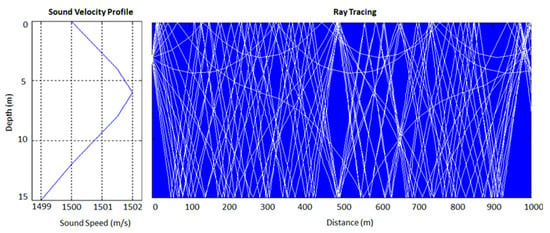

Figure 5.
Modeled underwater acoustic scattering in shallow water using the ray theory for different computed sound velocity profiles in the morning (top) and in the afternoon (bottom) at the study site. Sea bottom is comprised of sand.
Sound scattering estimations show that the sound energy reaches the sea bottom, that is, the sensor for the bottom-mounted deployment.
3.2. Classification of the Measurements
There were a total of 11,494 measurements to classify. All measurements were classified on the basis of the type of noise source, which was determined using AIS information and by listening to the noise, with the following results: 6074 measurements of shipping noise, 1097 measurements of natural noise, and 4323 measurements classified as other anthropogenic noise. Figure 6 shows the number of measurements per month with respect to their classification.
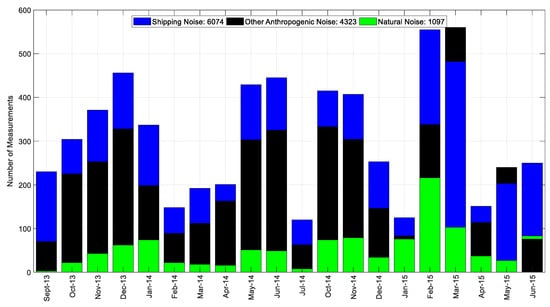
Figure 6.
Number of measurements per month classified into three groups: shipping, other anthropogenic, and natural noise measurements. The main source of underwater acoustic pollution in the study area was shipping traffic.
The total duration of all measurements was 860.61 h, distributed according to the classification groups into: 567.15 h of shipping noise measurements, 205.86 h of other anthropogenic noise measurements, and 87.6 h of natural noise measurements.
The different types of ship measured were extensive, and included cargo, fishing, passenger, pleasure, tug, sailing, and others. Table 1 shows the number of shipping noise measurements for each type of ship using the information obtained from the AIS receptor.

Table 1.
Number of shipping noise measurements for each type of ship.
3.3. Acoustic Analysis
The study of continuous low-frequency sound includes the analysis of the average temporal evolution of the 1/3 octave bands centered at 63 Hz and 125 Hz [51]. This study was carried out with the inclusion of the average trend for the unweighted SPL for overall bandwidth.
Figure 7 and Figure 8 show the monthly average maximum and mean values, respectively, for the 1/3 octave band centered at 63 Hz. Figure 9 and Figure 10 show the monthly average of the maximum and mean values, respectively, for the 1/3 octave band centered at 125 Hz. The graphic used is a boxplot, where the median is given by the center of the box, the 25th and 75th percentiles are given by the upper and lower boundaries of the box, the width of the box indicates the relative number of measurements per month, and the 5th and 95th percentiles are given by the bottom and top bars, respectively. Data points are outliers with values lower or higher than the 5th and 95th percentiles, respectively. In addition, the mean monthly values of shipping noise, other anthropogenic, and natural noise measurements are represented with blue, black, and green triangles, respectively. Please note that the minimum level in the ordinate axis is 70 and the maximum 180 dB re 1 µPa2.
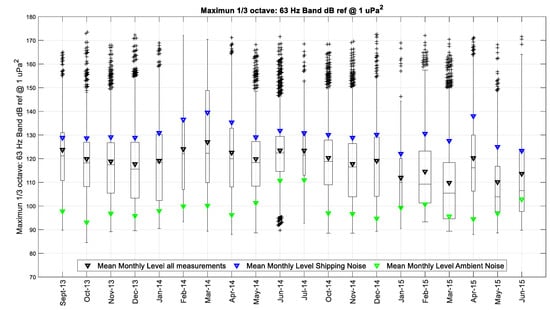
Figure 7.
Monthly average evolution of the maximum of the 1/3 octave band at 63 Hz of all measurements. The mean monthly values of shipping, other anthropogenic, and natural noise measurements are represented with blue, black, and green triangles, respectively.
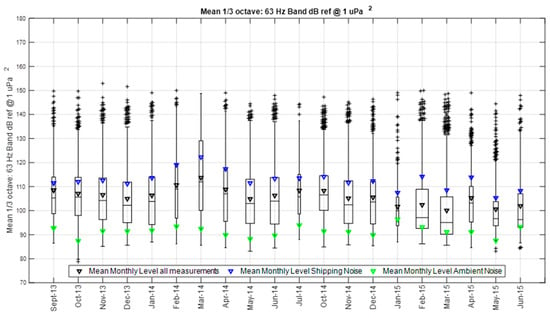
Figure 8.
Monthly average evolution of the mean of the 1/3 octave band at 63 Hz of all measurements. The mean monthly values of shipping, other anthropogenic, and natural noise measurements are represented with blue, black, and green triangles, respectively. The mean monthly va, of shipping, other anthropogenic, and natural noise measurements are represented with blue, black, and green triangles, respectively.
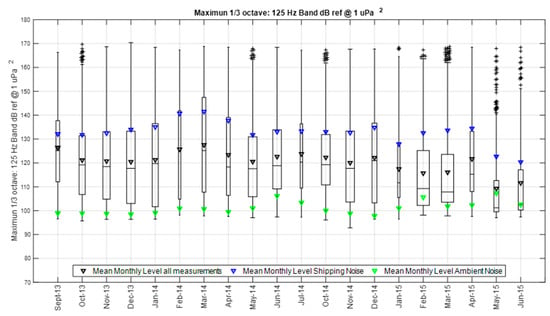
Figure 9.
Monthly average evolution of the maximum of the 1/3 octave band at 125 Hz. The mean monthly values of shipping, other anthropogenic, and natural noise measurements are represented with blue, black, and green triangles, respectively.
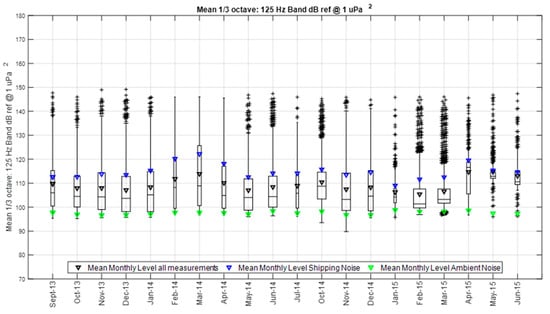
Figure 10.
Monthly average evolution of the mean of all measurements for the 1/3 octave band at 125 Hz. The mean monthly values of shipping, other anthropogenic, and natural noise measurements are represented as blue, black, and green triangles, respectively.
Figure 11 shows the monthly variation in the mean and median of the unweighted Sound Pressure Level calculated for the overall bandwidth also using boxplot graphics. Please note that the minimum SPL level in the ordinate axis is 100 dB, and the maximum is 170 dB re 1 µPa2.
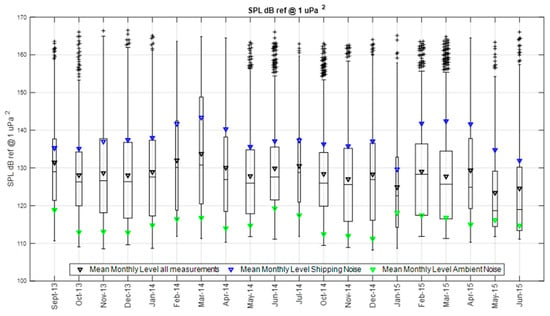
Figure 11.
Mean and median monthly evolution of the SPL level of all measurements. The mean monthly values of shipping, other anthropogenic and natural noise measurements are represented as blue, black and green triangles, respectively.
The annual average values of the maximum and mean monthly trends of the three groups on the basis of the classification of acoustic sources for the 1/3 octave bands centered at 63 and 125 Hz are shown in Figure 12 and Figure 13.
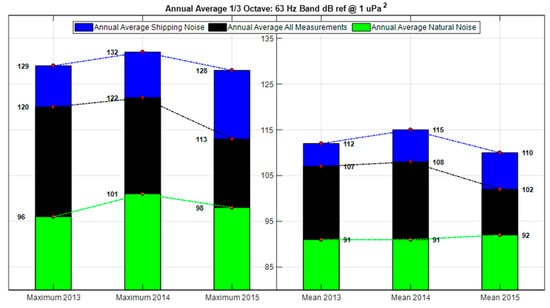
Figure 12.
Annual average of the maximum (left) and mean (right) levels of the 1/3 octave band centered at 63 Hz of the three groups of measurements according to the identification of the acoustic sources.
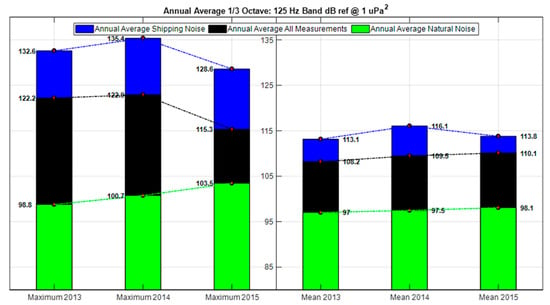
Figure 13.
Annual average of the maximum (left) and mean (right) levels of the 1/3 octave band centered at 125 Hz of the three groups of measurements according to the identification of the acoustic sources.
The annual average value of the SPL for the overall bandwidth of the three groups according to the identification of the acoustic sources is shown in Figure 14.
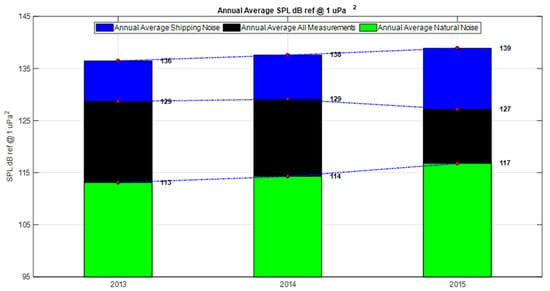
Figure 14.
Annual average of the three groups of measurements according to the identification of the acoustic sources of the mean value of SPL for the overall bandwidth.
The total average and standard deviation of the annual average of the acoustic indicators were analysed to assess the acoustic levels in the study area. Table 2 shows the total average and standard deviation of the mean values of the maximum and mean values of the 1/3 octave bands centered at 63 and 125 Hz.

Table 2.
Average and standard deviation of the mean and maximum values of the 1/3 octave bands centered at 63 and 125 Hz for all shipping and natural noise measurements.
Table 3 presents the total average and standard deviation of the unweighted SPL for the overall bandwidth.

Table 3.
Average and standard deviation of the SPL estimated for overall bandwidth for all shipping and natural noise measurements.
4. Discussion
The acoustic survey showed that sound energy reached the sensor location and depth throughout the day; therefore, the chosen location was suitable for long-term monitoring in the study area.
Following the process of classifying the measurements into the three groups, it was concluded that the number of measurements corresponding to natural noise amounted to only 9.5% of the total number of measurements. This indicates the high density of human activity in the study area, which makes it difficult to perform noise measurements without the presence of anthropogenic noise. Except in March and May 2015, the main activity to generate underwater acoustic pollution in the study area was shipping traffic. This result has also been reported by other researchers [11,13,17,18,19].
This is relevant information to put forward for future regulations with the aim of reducing and controlling the underwater pollution generated by shipping traffic.
As was expected, the monthly average levels of natural noise measurements were the quietest, with most months being lower than the 25th percentile of the average levels of all measurements. The average levels of shipping noise measurements were the loudest, with most months being higher than the 75th percentile of the average levels of all measurements.
The noise levels are not homogeneous throughout the monitoring time due to the variability of the Underwater Radiated Noise (URN) originating from the ships. The radiated noise levels depend on the type of ship; in fact, there are more levels higher than the 95th percentile corresponding to shipping noise than levels lower than the 5th percentile. The results show that the 1/3 octave band levels exhibit high variability. The dynamic range of the 1/3 octave bands was computed as the difference between the values of the 95th and 5th percentiles for each month. The mean values of the dynamic range of the maximum of the 1/3 octave bands centered at 63 and 125 Hz were 65 and 68 dB re 1 µPa2, respectively. The mean values of the dynamic range of the mean of the 1/3 octave bands centered at 63 and 125 Hz were 36 and 49 dB re 1 µPa2, respectively. The broadband source-level statistics for each ship class obtained by Veirs [73] also indicated a wide dynamic range in terms of acoustic measurements. The high dynamic range of the maximum and mean values of the 1/3 octave bands shows the dependency of the URN on the type of ship. Therefore, it is recommended that ship traffic be monitored to determine the underwater acoustic pollution and its monthly trend.
The values of the 1/3 octave bands centered at 63 and 125 Hz should not exceed 100 dB re 1 µPa2 [74]. Figure 15 details the differences between the limit of 100 dB and the monthly average variation in the maximum level of the 1/3 octave bands for natural and shipping noise. Negative and positive values in Figure 15 mean monthly average variation lower and higher than 100 dB, respectively.
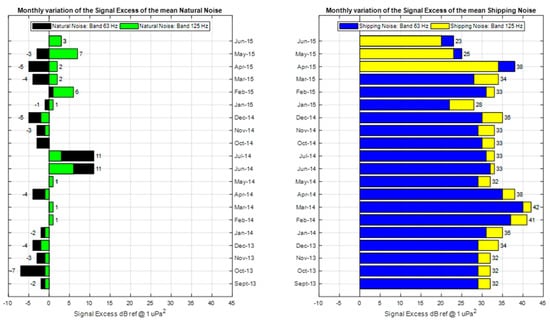
Figure 15.
Monthly variation in the signal excess referenced at 100 dB of the averaged maximum of the 1/3 octave bands centered at 63 and 125 Hz: natural noise (left) and shipping noise (right) measurements.
As shown in Figure 15, for as long as several months, the average value of natural noise was higher than the limit for both one-third octave bands. The 1/3 octave band centered at 125 Hz was the loudest band most months, reaching values higher than the reference during the year of 2015 and the months of May, June and July 2014, corresponding to the beginning of the summer season. The 1/3 octave band centered at 63 Hz also reached values higher than the reference when the 1/3 octave band centered at 125 Hz exceeded it, except during March, April and May 2015. The highest levels of the average natural noise were observed during June and July 2015, corresponding to the summer season.
All of the average values of the monthly trend of maximum levels of shipping noise for the one-third octave bands were higher than the limit of 100 dB. The 1/3 octave band centered at 125 Hz was the loudest band, except in April, May, and June 2015. It is relevant that the average maximum values of shipping noise measurements for the 1/3 octave band centered at 63 Hz made it the loudest band during April 2015, while for the same month, the average maximum values of natural noise measurements for the 1/3 octave band centered at 63 Hz made it the quietest band.
The annual average maximum values of natural noise in the 1/3 octave bands centered at 63 and 125 Hz increased by 2 and 4 dB, respectively, during the monitoring period, while the annual average of the mean values of both bands increased by 1 dB. The highest annual average of shipping noise measurements was monitored during 2014.
The increase in the annual average of the natural noise for the overall band was 4 dB. This could be caused by the increase in different human activities close to the monitored area. The study area is close to a shipyard, and this industrial activity could have generated a broadband background noise in shallow waters that was not identifiable in the measurements, and therefore its level was added to the noise of natural origin. The most significant data are that the annual average level of shipping noise for the overall bandwidth from 2013 to 2015 increased by 3 dB. The shipping noise is distributed along the overall frequency domain, not only in the 1/3 octave bands centered at 63 and 125 Hz. The annual average of the mean value of the SPL for the overall band obtained for shipping noise increased, while the annual average levels of this type of noise computed for both bands shown in Figure 12 and Figure 13 did not increase throughout the years. This indicates that underwater noise centered on different frequencies other than 63 and 125 Hz increased throughout this time. Codarin [75] monitored the underwater noise in the Gulf of Trieste, and concluded that the 200, 250, 315 and 400 Hz 1/3 octave bands were noisier than the 63 and 125 Hz ones. Therefore, the average annual level of shipping noise increases due to increasing levels of the 1/3 octave bands noisier than the 65 and 125 Hz bands.
Average and standard deviation of the mean and maximum values of the 1/3 octave bands shows that the shipping traffic activity close to the sensor increasesthe maximum values of the 1/3 octave bands centered at 63 and 125 Hz by on average 31 and 32 dB, respectively. The averages of the mean values of both bands increased by 22 and 17 dB, respectively. The loudest band on average is was 1/3 octave band centered at 125 Hz. The average level of the SPL overall band increased by 23 dB due to maritime traffic, as shown in Table 3.
Other research into underwater pollution in Mediterranean waters has reported similar values for 1/3 octave frequency bands centered at 63 and 125 Hz. The underwater noise in the Port of Civitavecchia, Italy, was assessed using different acoustic recording stations, finding maximum average levels of 133 and 126 dB for the 1/3 octave bands centered at 63 Hz and 125 Hz, respectively, at station 4A [76]. These maximum average levels are similar to the average maximum levels shown in Table 2, with the difference that the noisy band is the band centered at 63 Hz, instead of at 125 Hz. A mean ambient noise level of 131 dB re 1 µPa was measured in the Gulf of Trieste (Italy) [75], values of 130–138 dB re 1 µPa have been reported in Venice lagoon (Italy) [77], and maximum values of the SPL of 133 dB re 1 µPa and 128 dB re 1 µPa in the 1/3 octave bands centered at 63 and 125 Hz, respectively, were found in the Gulf of Catania (Ionian Sea) [78].
5. Conclusions
The port of Cartagena is an area with growing anthropogenic activity, with maritime traffic being the main source of underwater acoustic pollution. In this study, a long-term monitoring campaign was carried out according to Directive 2008/56/EC [50], investigating indicator 11.2.1, continuous low-frequency sound, in order to provide information about the one-third octave bands and overall bandwidth levels.
The measurements were performed using a calibrated hydrophone designed to meet the requirements stipulated in international standards, making accurate measurements of sound levels available for future studies and helping member states to establish threshold levels to achieve good environmental status. The sensor position was chosen by selecting locations with the highest shipping traffic density and using an acoustic survey to verify that the sound energy reached the sensor.
The duration of the monitoring campaign was three years, so this research represents the first measurements of SPL values for a long period of time in the Mediterranean Sea, in a strategic area of the Spanish coast.
In this research, the classification process allows the creation of three groups of measurements: shipping, natural, and other anthropogenic noise. Shipping traffic, except in March and May 2015, was the main source of noise pollution in the study area. Ships without AIS systems could have been the main sources of underwater sound in March and May 2015.
The results of the statistical analysis conclude that the 1/3 octave band centered at 125 Hz is the loudest. The natural noise demonstrated an increasing trend during the monitoring time, at up to 2 dB, 4 dB and 4 dB in the 63 1/3 octave band, the 125 Hz 1/3 octave band, and the overall bandwidth, respectively. These increases are due to the implications of human activity reaching levels higher than the recommended limits defined for GES. These levels increased drastically due to shipping traffic, reaching up to 130 and 133 dB for the average maximum of the 1/3 octave bands centered at 63 and 125 Hz, respectively. The average level of SPL for the overall bandwidth was 138 dB, indicating that there are louder bands in the underwater acoustic pollution than the 1/3 octave bands defined by European Commission [51]. In conclusion, to develop a representative monitoring programme with respect to the impact of the acoustic levels on marine life, it is recommended to add the SPL for the overall bandwidth, and not only investigate the one-third octave bands indicated by the MSFD Task Group 11 [74].
On the basis of the results of the present research, the following recommendations must be considered for ocean and costal management in order to control and reduce underwater acoustic pollution:
- In the study area, the noise levels are higher than the levels recommended in order to achieve good environmental status; therefore, mitigation policies are needed to control ship traffic and the underwater radiated noise it produces.
- Underwater radiated noise caused by ships must be regulated, controlled and standardized by shipyards in addition to the use of Spatio-Temporal Restrictions (STRs).
- The European Directive [61] must be extended to small ships in order to control the traffic of recreational and small ships.
- It is recommended to increase the analyzed acoustic bandwidth and include additional 1/3 octave bands in studies of underwater acoustic pollution and its impact on the maritime ecosystem.
Author Contributions
Conceptualization, F.J.R.; Formal analysis, F.J.R.; Investigation, F.J.R. and J.R.; Methodology, F.J.R., J.C. and P.P.; Project administration, J.R.; Validation, F.J.R., J.R., J.C. and P.P.; Writing—original draft, F.J.R.; Writing—review and editing, J.R., J.C. and P.P. All authors have read and agreed to the published version of the manuscript.
Funding
This research received no external funding.
Institutional Review Board Statement
Not applicable.
Informed Consent Statement
Not applicable.
Data Availability Statement
Not applicable.
Acknowledgments
This work was developed within the framework of the collaboration project between the company Sociedad Anónima de Electronica Submarina (SAES) and the Department of Physics, Systems Engineering and Signal Theory of the University of Alicante, as part of the doctoral thesis of Francisco Javier Rodrigo Saura.
Conflicts of Interest
The authors declare no conflict of interest.
References
- Wenz, G.M. Acoustic ambient noise in the ocean: Spectra and sources. J. Acoust. Soc. Am. 1962, 34, 1936–1956. [Google Scholar] [CrossRef]
- Richardson, W.J.; Greene, C.R., Jr.; Malme, C.I.; Thomson, D.H. Marine Mammals and Noise; Academic: New York, NY, USA, 1995; ISBN 9780125884419. [Google Scholar]
- Robinson, S.P.; Lepper, P.A.; Hazelwood, R.A. Good Practice Guide for Underwater Noise Measurement; NPL Good Practice Guide No. 133; National Measurement Office: London, UK; Marine Scotland: Edinburgh, Scotland; The Crown Estate: London, UK, 2014; ISSN 1368-6550. [Google Scholar]
- Hildebrand, J.A. Anthropogenic and natural sources of ambient noise in the ocean. Mar. Ecol. Prog. Ser. 2009, 395, 5–20. [Google Scholar] [CrossRef]
- Urick, R.J. Principles of Underwater Sound, 3rd ed.; McGraw-Hill: New York, NY, USA, 1983. [Google Scholar]
- Farina, A. Soundscape Ecology: Principles, Patterns, Methods and Applications; Springer: Berlin/Heidelberg, Germany, 2014. [Google Scholar] [CrossRef]
- Dekeling, R.P.A.; Tasker, M.L.; Van der Graaf, A.J.; Ainslie, M.A.; Andersson, M.H.; André, M.; Borsani, J.F.; Brensing, K.; Castellote, M.; Cronin, D.; et al. Monitoring Guidance for Underwater Noise in European Seas; Part II: Monitoring Guidance Specifications, JRC Scientific and Policy Report EUR 26555 EN; Publications Office of the European Union: Luxembourg, 2014. [Google Scholar] [CrossRef]
- Mitson, R.B.; Knudsen, H.P. Causes and effects of underwater noise on fish abundance estimation. Aquat. Living Resour. 2003, 16, 255–263. [Google Scholar] [CrossRef]
- Ross, D. Mechanics of Underwater Noise; Peninsula Publishing: Los Altos, CA, USA, 1987; ISBN 9780932146168. [Google Scholar]
- Ross, D. On ocean underwater ambient noise. Inst. Acoust. Bull. 1993, 18, 5–8. [Google Scholar]
- Ross, D. Ship sources of ambient noise. IEEE J. Ocean. Eng. 2005, 30, 257–261. [Google Scholar] [CrossRef]
- Bjorno, L. Man-made contributions to ambient noise in the seas. In Proceedings of the fourth European Conference on Underwater Acoustics 2; Alippi, A., Cannelli, G.B., Eds.; CNR-IDAC: Rome, Italy, 1998; pp. 543–548. [Google Scholar]
- Andrew, R.K.; Howe, B.M.; Mercer, J.A.; Dzieciuch, M.A. Ocean ambient sound: Comparing the 1960s with the 1990s for a receiver off the California coast. Acoust. Res. Lett. Online 2002, 3, 65–70. [Google Scholar] [CrossRef]
- Mazzuca, L.L. Potential Effects of Low Frequency Sound (LFS) from Commercial Vessels on Large Whales. Master Thesis, University of Washington, Seattle, WA, USA, 2001. [Google Scholar]
- McDonald, M.A.; Hildebrand, J.A.; Wiggins, S.M. Increases in deep ocean ambient noise in the Northeast Pacific west of San Nicolas Island, California. J. Acoust. Soc. Am. 2006, 120, 711–718. [Google Scholar] [CrossRef]
- Chapman, N.R.; Price, A. Low frequency deep ocean ambient noise trend in the Northeast Pacific Ocean. J. Acoust. Soc. Am. 2011, 129, EL161–EL165. [Google Scholar] [CrossRef]
- Hildebrand, J.A. Sources of Anthropogenic Sound in the Marine Environment. International Policy Workshop on Sound and Marine Mammals, London, UK, 28–30 September. 2004. Available online: https://www.mmc.gov/wp-content/uploads/hildebrand.pdf (accessed on 16 July 2022).
- McDonald, M.A.; Hildebrand, J.A.; Wiggins, S.M.; Ross, D. A 50 year comparison of ambient noise in Northeast Pacific west of San Nicolas Island, California. J. Acoust. Soc. Am. 2008, 124, 1985–1992. [Google Scholar] [CrossRef]
- Merchant, N.D.; Witt, M.J.; Blondel, P.; Godley, B.J.; Smith, G.H. Assessing sound exposure from shipping in coastal waters using a single hydrophone and automatic identification system (AIS) data. Mar. Pollut. Bull. 2012, 64, 1320–1329. [Google Scholar] [CrossRef]
- OSPAR Commission. Overview of the Impacts of Anthropogenic Underwater Sound in the Marine Environment; Report, 441; OSPAR Commission: London, UK, 2009. [Google Scholar]
- Frisk, G.V. Noiseonomics: The relationship between ambient noise levels in the sea and global economic trends. Sci. Rep. 2012, 2, 437. [Google Scholar] [CrossRef] [PubMed]
- Lesage, V.; Barrette, C.; Kingsley, M.; Sjare, B. The effect of vessel noise on the vocal behaviour of belugas in the St. Lawrence River estuary, Canada. Mar. Mammal Sci. 1999, 15, 65–84. [Google Scholar] [CrossRef]
- Finneran, J.J.; Schlundt, C.E.; Dear, R.; Carder, D.A.; Ridgway, S.H. Temporary shift in masked hearing thresholds in odontocetes after exposure to single underwater impulses from a seismic watergun. J. Acoust. Soc. Am. 2002, 111, 2929–2940. [Google Scholar] [CrossRef] [PubMed]
- Janik, V.M. Underwater acoustic communication networks in marine mammals. In Animal Communication Networks; McGregor, P.K., Ed.; Cambridge University Press: Cambridge, UK, 2005; pp. 390–415. [Google Scholar] [CrossRef]
- Madsen, P.T.; Wahlberg, M.; Tougaard, J.; Lucke, K.; Tyack, P. Wind turbine underwater noise and marine mammals: Implications of current knowledge and data needs. Mar. Ecol. Prog. Ser. 2006, 309, 279–295. [Google Scholar] [CrossRef]
- Lucke, K.; Lepper, P.A.; Hoeve, B.; Everaarts, E.; van Elk, N.; Siebert, U. Perception of low-frequency acoustic signals by a harbour porpoise (Phocoena phocoena) in the presence of simulated offshore wind turbine noise. Aquat. Mamm. 2007, 33, 55–68. [Google Scholar] [CrossRef]
- Clark, C.W.; Ellison, W.T.; Southall, B.L.; Hatch, L.; Van Parijs, S.M.; Frankel, A.; Ponirakis, D. Acoustic masking in marine ecosystems: Intuitions, analysis, and implication. Mar. Ecol. Prog. Ser. 2009, 395, 201–222. [Google Scholar] [CrossRef]
- Holles, S.; Simpson, S.D.; Radford, A.N.; Berten, L.; Lecchini, D. Boat noise disrupts orientation behaviour in a coral reef fish. Mar. Ecol. Prog. Ser. 2013, 485, 295–300. [Google Scholar] [CrossRef]
- Wysocki, L.E.; Dittami, J.P.; Ladich, F. Ship noise and cortisol secretion in European freshwater fishes. Biol. Conserv. 2006, 128, 501–508. [Google Scholar] [CrossRef]
- Southall, B.L.; Bowles, A.E.; Ellison, W.T.; Finneran, J.J.; Gentry, R.L.; Greene, C.R.; Kastak, D.; Ketten, D.R.; Miller, J.H.; Nachtigall, P.E.; et al. Marine mammal noise exposure criteria: Initial scientific recommendations. Aquat. Mamm. 2007, 33, 4. [Google Scholar] [CrossRef]
- Codarin, A.; Wysocki, L.E.; Ladich, F.; Picciulin, M. Effects of ambient and boat noise on hearing and communication in three fish species living in a marine protected area (Miramare, Italy). Mar. Pollut. Bull. 2009, 58, 1880–1887. [Google Scholar] [CrossRef]
- Popper, A.N.; Hastings, M.C. The effects of anthropogenic sources of sound on fishes. J. Fish Biol. 2009, 75, 455–489. [Google Scholar] [CrossRef] [PubMed]
- Rolland, R.M.; Parks, S.E.; Hunt, K.E.; Castellote, M.; Corkeron, P.J.; Nowacek, D.P.; Wasser, S.K.; Kraus, S.D. Evidence that ship noise increases stress in right whales. Proc. R. Soc. B Biol. Sci. 2012, 279, 2363–2368. [Google Scholar] [CrossRef] [PubMed]
- Miller, P.; Biassoni, N.; Samuels, A.; Tyack, P. Whale songs lengthen in response to sonar. Nature 2000, 405, 903. [Google Scholar] [CrossRef] [PubMed]
- Slabbekoorn, H.; Bouton, N.; van Opzeeland, I.; Coers, A.; ten Cate, C.; Popper, A. A noisy spring: The impact of globally rising underwater sound levels on fish. Trends Ecol. Evol. 2010, 25, 419–427. [Google Scholar] [CrossRef]
- André, M.; van der Schaar, M.; Zaugg, S.; Houégnigan, L.; Sánchez, A.; Castell, J. Listening to the deep: Live monitoring of ocean noise and cetacean acoustic signals. Mar. Pollut. Bull. 2011, 63, 18–26. [Google Scholar] [CrossRef]
- Castellote, M.; Clark, C.W.; Lammers, M.O. Acoustic and behavioural changes by fin whales (Balaenoptera physalus) in response to shipping and airgun noise. Biol. Conserv. 2012, 147, 115–122. [Google Scholar] [CrossRef]
- Fewtrell, J.; McCauley, R. Impact of air gun noise on the behaviour of marine fish and squid. Mar. Pollut. Bull. 2012, 64, 984–993. [Google Scholar] [CrossRef]
- Dyndo, M.; Wisniewska, D.M.; Rojano-Donate, L.; Madsen, P.T. Harbour porpoises react to low levels of high frequency vessel noise. Sci. Rep. 2015, 5, 11083. [Google Scholar] [CrossRef]
- Gomez, C.; Lawson, J.; Wright, A.J.; Buren, A.; Tollit, D.; Lesage, V. A systematic review on the behavioural responses of wild marine mammals to noise: The disparity between science and policy. Can. J. Zool. 2016, 94, 801–819. [Google Scholar] [CrossRef]
- Dahlheim, M.E. Bio-Acoustics of the Gray Whale (Eschrichtius Robustus). Ph.D. Thesis, University of British Columbia, Vancouver, Canada, 1987. [Google Scholar] [CrossRef]
- Dahlheim, M.E.; Castellote, M. Changes in the acoustic behaviour of gray whales Eschrichtius robustus in response to noise. Endanger. Species Res. 2016, 31, 227–242. [Google Scholar] [CrossRef]
- Croll, D.A.; Clark, C.W.; Acevedo, A.; Tershy, B.; Flores, S.; Gedamke, J.; Urban, J. Bioacoustics: Only male fin whales sing loud songs—these mammals need to call long distance when it comes to attracting females. Nature 2002, 417, 809. [Google Scholar] [CrossRef] [PubMed]
- Bryant, P.J.; Lafferty, C.M.; Lafferty, S.K. Reoccupation of Laguna Guerrero Negro, Baja California, Mexico, by gray whales. In The Gray Whale Eschrichtius Robustus; Jones, M.L., Swartz, S.L., Leatherwood, S., Eds.; Academic Press: Orlando, FL, USA, 1984; pp. 375–387. [Google Scholar]
- Miksis-Olds, J.L.; Donaghay, P.L.; Miller, J.H.; Tyack, P.L.; Nystuen, J.A. Noise level correlates with manatee use of foraging habitats. J. Acoust. Soc. Am. 2007, 121, 3011–3020. [Google Scholar] [CrossRef] [PubMed]
- Picciulin, M.; Sebastianutto, L.; Codarin, A.; Calcagno, G.; Ferrero, E.A. Brown meagre vocalization rate increases during repetitive boat noise exposures: A possible case of vocal compensation. J. Acoust. Soc. Am. 2012, 132, 3118–3124. [Google Scholar] [CrossRef] [PubMed]
- Simpson, S.D.; Purser, J.; Radford, A.N. Anthropogenic noise compromises antipredator behaviour in European eels. Glob. Chang. Biol. 2015, 21, 586–593. [Google Scholar] [CrossRef]
- Hawkins, A.D.; Popper, A.N. A sound approach to assessing the impact of underwater noise on marine fishes and invertebrates. ICES J. Mar. Sci. 2017, 74, 635–651. [Google Scholar] [CrossRef]
- International Maritime Organization (IMO); Marine Environment Protection Committee (MEPC). Noise from Commercial Shipping and Its Adverse Impact on Marine Life; MEPC 59/19 edition; International Maritime Organization: London, UK, 2009. [Google Scholar]
- European Parliament and Council. Directive 2008/56/EC of the European Parliament and of the Council of 17 June 2008 Establishing a Framework for Community Action in the Field of Marine Environmental Policy (Marine Strategy Framework Directive); European Parliament and Council: Strasbourg, France, 2008. [Google Scholar]
- European Commission. Decision 2010/477/EU of the European Commission of 1 September 2010 on Criteria and Methodological Standards on Good Environmental Status of Marine Waters; European Parliament and Council: Strasbourg, France, 2010. [Google Scholar]
- Van der Graaf, A.J.; Ainslie, M.A.; André, M.; Brensing, K.; Dalen, J.; Dekeling, R.P.A.; Robinson, S.; Tasker, M.L.; Thomsen, F.; Werner, S. European Marine Strategy Framework Directive-Good Environmental Status (MSFD GES); Report of the Technical Subgroup on Underwater noise and other forms of energy; Miliu Ltd.: Brussels, Belgium, 2012. [Google Scholar]
- Jones, D.O.; Gates, A.R.; Huvenne, V.A.; Phillips, A.B.; Bett, B.J. Autonomous marine environmental monitoring. Application in decommissioned oil fields. Sci. Total Environ. 2019, 668, 835–853. [Google Scholar] [CrossRef]
- Autoridad Portuaria de Cartagena (APC). Declaración Ambiental 2013. Autoridad Portuaria de Cartagena. Available online: http://www.apc.es/wcm/connect/webapc/6d3db0d5-49b3-4e87-8160-5fee8580a670/Declaracion_EMAS_2013.pdf?MOD=AJPERES&CONVERT_TO=url&CACHEID=ROOTWORKSPACE.Z18_I8C61OK0N0QU80AV9BS3MT0S75-6d3db0d5-49b3-4e87-8160-5fee8580a670-m57pNzJ (accessed on 16 July 2022).
- Autoridad Portuaria de Cartagena (APC). Declaración Ambiental 2014. Autoridad Portuaria de Cartagena. Available online: http://www.apc.es/wcm/connect/webapc/c249d946-dec8-46a5-bcdd-7eee4f0ac44b/Declaracion_EMAS_2014.pdf?MOD=AJPERES&CONVERT_TO=url&CACHEID=ROOTWORKSPACE.Z18_I8C61OK0N0QU80AV9BS3MT0S75-c249d946-dec8-46a5-bcdd-7eee4f0ac44b-m57pUS (accessed on 16 July 2022).
- Autoridad Portuaria de Cartagena (APC). Declaración Ambiental 2015. Autoridad Portuaria de Cartagena. Available online: http://www.apc.es/wcm/connect/webapc/2617ce65-ee31-4833-be90-c78ee2c9a39b/Declaracion_EMAS_2015.pdf?MOD=AJPERES&CONVERT_TO=url&CACHEID=ROOTWORKSPACE.Z18_I8C61OK0N0QU80AV9BS3MT0S75-2617ce65-ee31-4833-be90-c78ee2c9a39b-m57p.sU (accessed on 16 July 2022).
- Mackenzie, K.V. Nine-term equation for sound Speed in the Oceans. J. Acoust. Soc. Am. 1981, 70, 807–812. [Google Scholar] [CrossRef]
- Medwin, H.; Clay, C.S. Fundamentals of Acoustical Oceanography; Academic Press: Cambridge, MA, USA, 1997; ISBN 978-0-12-487570-8. [Google Scholar] [CrossRef]
- Etter, P.C. Underwater Modelling and Simulation, 3rd ed.; Spon Press: New York, NY, USA, 2002; ISBN 0–419–26220–2. [Google Scholar]
- Hovem, J.M. Underwater acoustics: Propagation, devices and systems. J. Electroceramics 2007, 19, 339–347. [Google Scholar] [CrossRef]
- European Directive. Directive 2002/59/EC of the European Parliament and of the Council of 27 JUNE 2002 Establishing a Community Vessel Traffic Monitoring and Information System and Repealing Council Directive 93/75/EEC; European Parliament and Council: Luxembourg, 2002. [Google Scholar]
- NATO Standardization Agreement N°1136 (STANAG); Standards for Use When Measuring and Reporting Radiated Noise Characteristics of Surface Ships, Submarines, Helicopters, etc. in Relation to Sonar Detection and Torpedo Risk. NATO: Brussels, Belgium, 1995.
- IEC 60565; Underwater Acoustics-Hydrophones-Calibration in the Frequency Range 0.01 Hz to 1 MHz. International Electrotechnical Commission: Geneva, Switzerland, 2006.
- Tichavska, M.; Cabrera, F.; Tovar, B.; Araña, V. Use of the Automatic Identification System in Academic Research. In Computer Aided Systems Theory–EUROCAST 2015; Moreno-Díaz, R., Pichler, F., Quesada-Arencibia, A., Eds.; EUROCAST 2015. Lecture Notes in Computer Science; Springer: Cham, Denmark, 2015; Volume 9520. [Google Scholar] [CrossRef]
- Dekeling, R.P.A.; Tasker, M.L.; Van der Graaf, A.J.; Ainslie, M.A.; Andersson, M.H.; André, M.; Borsani, J.F.; Brensing, K.; Castellote, M.; Cronin, D.; et al. Monitoring Guidance for Underwater Noise in European Seas; Part I: Executive Summary, JRC Scientific and Policy Report EUR 26557 EN; Publications Office of the European Union: Luxembourg, 2014. [Google Scholar] [CrossRef]
- Dekeling, R.P.A.; Tasker, M.L.; Van der Graaf, A.J.; Ainslie, M.A.; Andersson, M.H.; André, M.; Borsani, J.F.; Brensing, K.; Castellote, M.; Cronin, D.; et al. Monitoring Guidance for Underwater Noise in European Seas; Part III: Background Information and Annexes, JRC Scientific and Policy Report EUR 26556 EN; Publications Office of the European Union: Luxembourg, 2014. [Google Scholar] [CrossRef]
- Ainslie, M.A. Standard for Measurements and Monitoring of Underwater Noise, Part I: Physical Quantities and Their Units; Rep. No TNO-DV 2011 C235; TNO: The Hague, The Netherlands, 2011. [Google Scholar]
- De Jong, C.A.F.; Ainslie, M.A.; Blacquiere, G. Standard for Measurements and Monitoring of Underwater Noise. Part II: Procedures for Measuring Underwater Noise in Connection with Offshore Wind Farm Licensing. TNO-DV 2011 C251. 2011. Available online: https://tethys.pnnl.gov/sites/default/files/publications/TNO-Report-2011.pdf (accessed on 16 July 2022).
- ISO 18405; Underwater Acoustics. Terminology. ISO: Geneva, Switzerland, 2017.
- IEC 61260; Electroacoustics-Octave-Band and Fractional-Octave-Band Filters-Part 1: Specifications. International Electrotechnical Commission: Geneva, Switzerland, 2014.
- Lyons, R.G. Understanding Digital Signal Processing, 3rd ed.; Prentice Hall: Hoboken, NJ, USA; ISBN 0-13-702741-9.
- Erbe, C.; MacGillivray, A.; Williams, R. Mapping cumulative noise from shipping to inform marine spatial planning. J. Acoust. Soc. Am. 2012, 132, EL423–EL428. [Google Scholar] [CrossRef]
- Veirs, S.; Veirs, V.; Wood, J.D. Ship noise extends to frequencies used for echolocation by endangered killer whales. PeerJ 2016, 4, e1657. [Google Scholar] [CrossRef]
- Tasker, M.; Amundin, M.; Andre, M.; Hawkins, A.; Lang, W.; Merck, T.; Scholik-Schlomer, A.; Teilmann, J.; Thomsen, F.; Werner, S.; et al. Marine Strategy Framework Directive Task Group 11. Report Underwater Noise and Others Forms of Energy; Publications Office of the European Union: Luxembourg, 2010. [Google Scholar] [CrossRef]
- Codarin, A.; Picciulin, M. Underwater noise assessment in the Gulf of Trieste (Northern Adriatic Sea, Italy) using an MSFD approach. Mar. Pollut. Bull. 2015, 101, 694–700. [Google Scholar] [CrossRef] [PubMed]
- Cafaro, V.; Piazzolla, D.; Melchiorri, C.; Burgio, C.; Fersini, G.; Conversano, F.; Piermattei, V.; Marcelli, M. Underwater noise assessment outside harbor areas: The case of Port of Civitavecchia, northern Tyrrhenian Sea, Italy. Mar. Pollut. Bull. 2018, 133, 865–871. [Google Scholar] [CrossRef] [PubMed]
- Picciulin, M.; Bolgan, M.; Codarin, A.; Fiorin, R.; Zucchetta, M.; Malavasi, S. Passive acoustic monitoring of Sciaena umbra on rocky habitats in the Venetian littoral zone. Fish. Res. 2013, 145, 76–81. [Google Scholar] [CrossRef]
- Viola, S.; Grammauta, R.; Sciacca, V.; Bellia, G.; Beranzoli, L.; Buscaino, G.; Carusoa, F.; Chierci, F.; Cuttone, G.; D’Amico, A.; et al. Continuous monitoring of noise levels in the Gulf of Catania (Ionian Sea). Study of correlation with ship traffic. Mar. Pollut. Bull. 2017, 121, 97–103. [Google Scholar] [CrossRef] [PubMed]
Publisher’s Note: MDPI stays neutral with regard to jurisdictional claims in published maps and institutional affiliations. |
© 2022 by the authors. Licensee MDPI, Basel, Switzerland. This article is an open access article distributed under the terms and conditions of the Creative Commons Attribution (CC BY) license (https://creativecommons.org/licenses/by/4.0/).